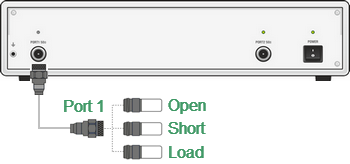Full one-port calibration (SOL) is used for reflection coefficient measurements (S11 or S22). The three calibration standards (SHORT, OPEN, LOAD) are measured (See figure below) in the process of this calibration. Measurement of the three standards allows for acquisition of all the three error terms (Ed, Es, and Er) of a one-port model. Full one-port calibration is a highly accurate method for one-port reflection measurements.

Before starting calibration perform, select an active channel, set the parameters of the channel (frequency range, IF bandwidth, etc), and select the calibration kit.
|
To open full one-port calibration submenu, use the following softkeys: Calibration > Calibrate > Full 1-Port Cal |
|
Select the test port to be calibrated using Select Port. Switch between the test ports (measured parameters) using this softkey. |
|
Connect SHORT, OPEN, and LOAD standards to the selected test port in any consequence as shown in the above figure. Perform measurements clicking the softkey Open, Short, Load corresponding to the connected standard. The instrument status bar will indicate Calibration in progress... when the measurement is in progress. On completion of the measurement, a check mark will appear in the left part of the softkey. |
|
To complete the calibration procedure, click Apply softkey. This will activate the process of calibration coefficient table calculation and saving it into the memory. The error correction function will also be automatically enabled. |
|
To clear the measurement results of the standard, click Cancel softkey. This softkey does not cancel the current calibration. To disable the current calibration, turn off the error correction function (See Error Correction Disabling). |
|
|
note |
The calibration status can be checked in channel status bar (See General error correction status table) or in trace status field (See Trace error correction status table). |






